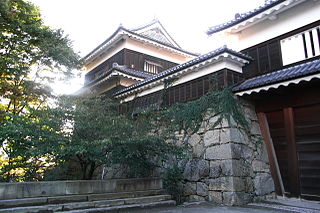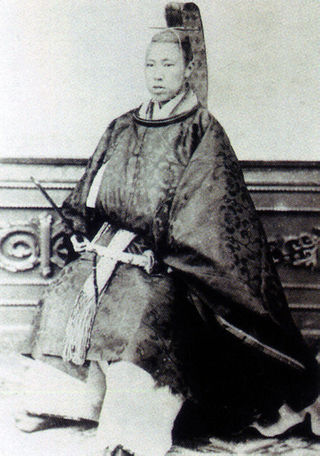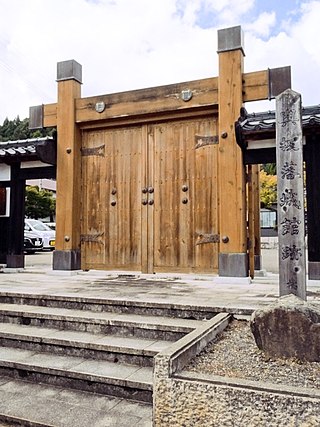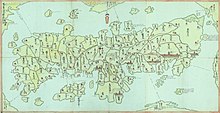
The Matsudaira clan was a Japanese samurai clan that descended from the Minamoto clan. It originated in and took its name from Matsudaira village, in Mikawa Province. During the Sengoku period, the chieftain of the main line of the Matsudaira clan, Matsudaira Motoyasu became a powerful regional daimyo under Oda Nobunaga and Toyotomi Hideyoshi and changed his name to Tokugawa Ieyasu. He subsequently seized power as the first shōgun of the Tokugawa shogunate which ruled Japan during the Edo period until the Meiji Restoration of 1868. Under the Tokugawa shogunate, many cadet branches of the clan retained the Matsudaira surname, and numerous new branches were formed in the decades after Ieyasu. Some of those branches were also of daimyō status.

Nabeshima Naoshige was a warlord of the Sengoku and early Edo periods and progenitor of the Nabeshima lords of the Saga Domain. Naoshige was the second son of Nabeshima Kiyofusa. His mother was the daughter of Ryūzōji Iesumi. He was a vassal of the Ryūzōji clan during the Sengoku period of the 16th century.
The Daidōji clan (大道寺氏) were a Japanese samurai kin group in the Kamakura period.

Nabeshima clan is a Japanese samurai kin group.

The Saga Domain, also known as Hizenhan, was a Tozama domain situated in Saga District, Hizen Province. The Nabeshima clan held the position of the domain's lord, leading to it being commonly referred to as the Nabeshima Domain. This domain played a significant role in the Meiji Restoration, being part of the Satsumacho Toi. Presently, it is encompassed within Saga Prefecture and Nagasaki Prefecture, with the domain office situated in Saga Castle, which is now known as Saga City. Initially, the feudal lord of the Saga Domain was the Ryuzoji clan, later succeeded by the Nabeshima clan. The domain boasted a substantial stone height of 357,000 koku, signifying its importance and wealth. Additionally, there were subsidiary domains under its jurisdiction, including the Hasunoike Domain , the Ogi Domain, and the Kashima Domain, further showcasing the domain's influence and power.

Takatō Domain was a domain of the Tokugawa Shogunate of Japan during the Edo period from 1600 to 1871.
Hasunoike Domain was a Japanese domain of the Edo period. It is associated with Hizen Province in modern-day Saga Prefecture.

Nishi-Ōhira Domain was a Japanese feudal domain of the Edo period Tokugawa shogunate, located in Nukata District Mikawa Province, Japan. It was centered on what is now part of the city of Okazaki, Aichi.

Mibu Domain was a feudal domain under the Tokugawa shogunate of Edo period Japan, located in Tsuga District of Shimotsuke Province, Japan. It was centered on Mibu Castle in what is now part of the town of Mibu, Tochigi. Mibu was ruled through much of its history by a branch of the fudai Torii clan.

Niwase Domain was a feudal domain under the Tokugawa shogunate of Edo period Japan, in what is now central Okayama Prefecture. It controlled a small portion of eastern Bitchū Province and was centered around Niwase jin'ya in what is now Kita-ku, Okayama. It was ruled for most its history by a branch of the Itakura clan. It was dissolved in the abolition of the han system in 1871 and is now part of Okayama Prefecture.Inukai Tsuyoshi, who became Prime Minister of Japan, was from Niwase Domain.

Ueda Domain was a feudal domain under the Tokugawa shogunate of Edo period Japan. It is located in Shinano Province, Honshū. The domain was centered at Ueda Castle, located in what is now part of the city of Ueda in Nagano Prefecture.

Tottori Domain was a feudal domain under the Tokugawa shogunate of Edo period Japan, in what is now Tottori Prefecture on the island of Honshu. It controlled all of Inaba Province and virtually all of Hōki Province was centered around Tottori Castle, and was ruled throughout its history by a branch of the Ikeda clan. Tottori Domain was dissolved in the abolition of the han system in 1871 and is now part of Tottori Prefecture. Tottori Domain had two sub-domains, Shikano Domain (鹿奴藩) and Wakasa Domain (若桜藩). In addition, the two branches of the Arao clan, who served as hereditary karō of the clan and castellans of Yonago Castle and Kurayoshi Jin'ya both had kokudaka equivalents to that of daimyō.

Numazu Domain was a feudal domain under the Tokugawa shogunate of Edo period Japan located in Suruga Province. It was centered on Numazu Castle in what is now the city of Numazu, in modern-day Shizuoka Prefecture.
Ogi Domain was a Japanese domain in the Edo period. It is associated with Hizen Province in modern-day Saga Prefecture on the island of Kyūshū.

Yoita Domain was a fudai feudal domain under the Tokugawa shogunate of Edo period Japan. It was located in Echigo Province, Honshū. The domain was centered at Yoita Jin'ya, located in what is now part of the city of Nagaoka in Niigata Prefecture.
Takanabe Domain was a feudal domain under the Tokugawa shogunate of Edo period Japan, in what is now central Miyazaki Prefecture. It was centered around Takanabe Castle and was ruled by the tozama daimyō Akizuki clan for all of its history. In its early years, it was called Takarabe Domain (財部藩) after the location of its original seat.

Shibata Domain was a tozama feudal domain under the Tokugawa shogunate of Edo period Japan. It is located in Echigo Province, Honshū. The domain was centered at Shibata Castle, located in what is now the city of Shibata in Niigata Prefecture. It was ruled for all of its history by the Mizoguchi clan.

Kururi Domain was a feudal domain under the Tokugawa shogunate of Edo period Japan, located in Kazusa Province, Japan. It was centered on Kururi Castle in what is now the city of Kimitsu, Chiba.

Hirose Domain was a Japanese domain of the Edo period. It was associated with Izumo Province in modern-day Shimane Prefecture.

Kurobane Domain was a feudal domain under the Tokugawa shogunate of Edo period Japan, located in the Nasu District of Shimotsuke Province, Japan. It was centered on Kurobane jin'ya in what is now part of the city of Ōtawara, Tochigi. Kurobane was ruled through all of its history by the tozama Ōzeki clan.





















